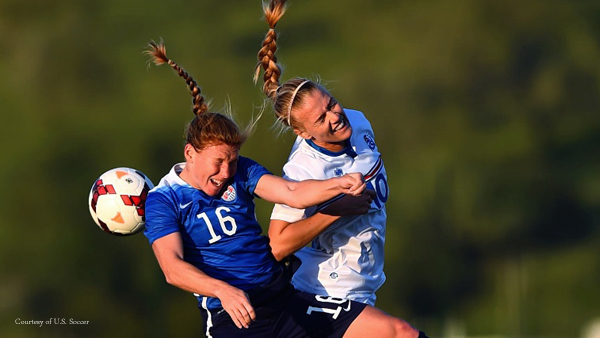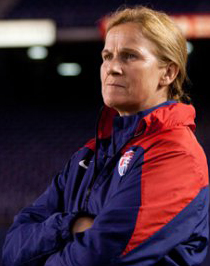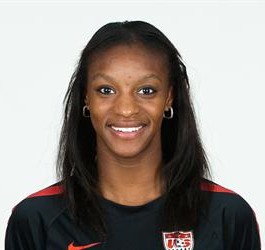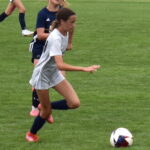USWNT’s performances in the Algarve Cup are worrying, not reassuring

The U.S. Women’s National Team went undefeated in their group-stage matches at the Algarve Cup in Portugal, beating Norway 2-1 and Switzerland 3-0 before Monday’s scoreless draw with Iceland to set up a championship final with France. There is a temptation to say that these victories over lesser opposition should be regarded as an encouraging sign, that they show that the U.S. have begun to shake off the doldrums exhibited in recent months against Brazil, France and England.
 That temptation should be resisted.
That temptation should be resisted.
What we saw from the USWNT in these matches was more of the same – slow and ineffectual offense, shaky defense – rather than anything to banish the continuing doubts about Jill Ellis’ ability to mold the U.S. squad into a World-Cup-winning side.
+READ: USWNT earns berth in Algarve Cup championship with 0-0 draw vs. Iceland
Start with the attack. All three opponents chose largely to drop off and dare the U.S. to break them down. And to a large extent, it worked. The U.S., however many long passes they launched forward, rarely put either opponent under sustained first-half pressure. Indeed, against mighty Switzerland (No. 19 in the current FIFA World Rankings), the Yanks were held at arm’s length for 50 minutes with almost frightening ease, and Iceland (global rank: No. 20) conceded possession but weathered only five U.S. shots on target.
When the opening U.S. goals did come in the second half of each match, they were down to a moment of individual brilliance from Carli Lloyd (Norway), and calamitous set-piece defending (Switzerland), rather than strong combination play or quick ball movement. Nor was this simply a case of poor individual performances on the day. The shortcomings of the U.S. attack are instead the result of playing the way that Ellis is asking them to play.
The U.S. attacking plan at the moment is straightforward. The team lines up in a 4‑2‑2‑2 with a narrow midfield. When the U.S. start play from the back, either Lauren Holiday or Morgan Brian drops deep toward the center backs to receive the ball while the front two midfielders (most often Carli Lloyd and Christen Press) and the fullbacks push up—the midfielders staying narrow, the fullbacks pulling wide.
Holiday or Brian will most often then send a long ball up to one of the attacking midfielders or the forwards, or wide to a fullback. Short passes through the center of midfield are almost unheard of, for the simple reason that none of the front four are to make themselves available to receive that kind of pass.
This approach has several pernicious (and foreseeable) consequences. It is slow, because finding and picking out an open player deep for a long pass takes longer than a simple five- or 10-yard ball.
+READ: USWNT tops Switzerland 3-0 at Algarve Cup, moves into first place in Group B
Half an hour into the Norway match, for example, the sideline mics picked up Ellis asking the center backs and Holiday to move the ball faster; at that particular moment, neither the fullbacks nor the front four were within 20 yards of the ball.
It was striking that the U.S. moved the ball most quickly (including the passing sequences that led to the penalty against Norway and Amy Rodriguez’s goal against Switzerland) when picking up possession after a turnover, rather than when playing out from the back in the pattern and shape demanded by Ellis.
This approach is simpler to defend, because it limits the attacking midfielders and the forwards to a smaller, more predictable area of the field.
And it does nothing to pull defenders in a low block out of their shape, or drag them forward and create enough space in behind for someone like Press or Alex Morgan to use.
These shortcomings are only exacerbated when Abby Wambach starts. Given her lack of mobility, she contributes little herself against fresh defenders – against Norway she had 11 touches with her feet in 56 minutes, a decent (off-target) shot from 20 yards, and a risible flop in the six-yard box. And her presence pushes the offensive plan ever closer to simply playing the ball in her general direction and looking for knockdowns.
+READ: USWNT opens Algarve Cup with 2-1 victory against Norway
The problems, though, are there whether Wambach is playing or not: In the first half against Switzerland, for example, with Morgan and Press starting at forward, the USWNT attack verged on the stagnant. Overall, in the five matches played since Ellis abandoned the 4-3-3 after its shredding by Brazil’s Marta, the U.S. have a grand total of three goals from open play.
The current U.S. tactics, are not merely ineffective in attacking an opposition defense set up in a low block, though. They also open up the U.S. defense for quick counters from that block when the attack breaks down.
The narrow midfield of the 4-2-2-2 requires the fullbacks to push up for width and leave space behind them, while making it harder for the attacking midfielders to track back and provide cover on the flanks. Doing so thus puts great pressure on Holiday and Brian as the more defensive midfielders, though they are both naturally attacking players who are still learning the position.
It was notable that in the run-up to Norway’s goal, both Holiday and Press failed to track a wide runner, leading to a 2v1; on the ensuing cross, Brian completely lost track of Ada Hegerberg, whom she was supposed to be marking, and Hegerberg duly took advantage of the free header presented to her.
Why Ellis would rather put two novices in one of the most important positions on the pitch, rather than bring in new players with proven talent and experience in the role, is of course one of the great mysteries of this World Cup cycle.
+READ:USWNT analysis: Will a real No. 6 please stand up?
The fullbacks in the 4-2-2-2, for their part, must be continually aware of when they can get forward and when they must drop back, and be strong 1v1 defenders as well. This too is a problem area for the USWNT at present, particularly at left back. Ellis has brought back Lori Chalupny from years of exile, presumably out of dissatisfaction with options like Kelley O’Hara, has not played at fullback in years and has looked distinctly shaky against strong opposition.

Meghan Klingenberg has been hardly been a lockdown defender either – against Norway, for example, she was caught ball-watching while an attacker snuck in behind her on three different occasions in her 45 minutes on the field. And Crystal Dunn has simply been MIA. (At this point, we are left to think either that Ellis does not rate Dunn at all at fullback, which seems hard to fathom, or that Dunn has been suffering from an ongoing injury that the USWNT have chosen to keep secret, which would hardly be to the team’s credit.)
For all these problems, the real test is Wednesday’s championship match vs. red-hot France, the team that comprehensively defeated the USWNT last month.
In these circumstances it will be important to remember that sometimes the light at the end of the tunnel is daylight – and sometimes it is an oncoming train.
SOCCERWIRE MARKETPLACE
- Start the Season Strong at Loudoun Premier Cup!
- 50th Annual Rael Vodicka Memorial Tournament
- Soccer Marketing Internships at The St. James FC
- Job Opening: The St. James FC Goalkeeper Academy Coach
- Full-Time Director of Goalkeeping for The St. James FC
- visitRaleigh.com Showcase Series 2025, hosted by NCFC Youth
- Join Official Elite Summer Soccer Camps with Europe’s Top Pro Clubs!
- OFFICIAL BAYERN MUNICH SUMMER CAMPS U.S.
- OFFICIAL FC BARCELONA CAMPS U.S.
- The Cup San Diego - Hosted by Legends FC
College Recruiting Commitment Tracker
Featured Players
COLLEGE RECRUITING STARTS HERE
Join the SoccerWire College Soccer Recruiting Search Engine and learn how to be seen OVER 1 MILLION TIMES PER YEAR.
- Basic $99 – for life
- Featured $299 – for life
- Featured PLUS $399 – for life











